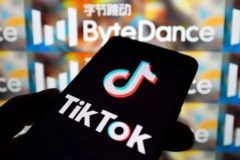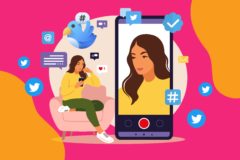This article was contributed to TechCabal by Elizma Nolte, Meta’s head of marketing for sub-Saharan Africa.
Tapping into creators is an extremely valuable tool for businesses, but you need to know how to work together authentically to reach the right people.
Also dubbed the “business of influence”, the creator economy can be traced back to as early as the late 2000s when blogging gave rise to an era of user-generated content.
Today, the creator economy is more diversified, with an estimated 2.6 million social media users in Zambia, as of January 2021. This fact alone is reason enough to explore why creators are important and understand how businesses can work with them to tap into this multibillion-dollar industry.
People don’t come to social media to shop—they come to be entertained and inspired. They are on a journey of discovery. And as they go along this journey, they come across product and service recommendations from trusted and influential members of their communities who act as guides.
But why are we drawn to creators in the first place?
The allure of creators
The biggest misconception is that people are attracted to a creator’s fame, whereas it’s their creative originality that is key. From dancers to make-up artists, creators have a unique personality or craft that entertains and inspires us and—most importantly—offers us an original perspective.
Why is this useful for businesses? Because people trust creators.
Around 63% of 18–34-year-olds say that they trust what a creator says about a brand more than what a brand says about itself.1
In this way, creators act as guides and a powerful word-of-mouth discovery tool, helping us to decide which products or brands to consider and purchase. Have you bought something over the past 18 months because a creator showed you something you liked?
Zambian musician and Meta Creator of Tomorrow, Ruth Ronnie, uses social media to grow her audience, promote her content, and create a community of shared trust. She says:
“Instagram and Facebook have majorly supported the growth of my work. Sharing my work and day-to-day life on these platforms has led to new people discovering me and people who already follow me having easier access to everything I post. I’m also able to get feedback from my audience and, sometimes, even involve them in my creative processes. Apart from my own work, I’ve been able to share products and brands I love with my audience. Since I’ve built a community that trusts me, they trust my recommendations and are always excited to try out the brands I mention.”
And, it’s not a one-off. In fact, 82% of people discover products and brands across Meta’s technologies.2
Businesses and creators can work together
So, we understand why people interact with creators, but how can a business authentically tap into this as a useful tool for marketing?
The key to this is storytelling. Content, created by a brand or otherwise, needs to earn its place in a social media feed. It needs to be arresting, engaging and entertaining. Businesses need to find creators that will effectively harness the power of storytelling for their brand. For example, 82% of people would try, purchase or recommend a brand when the content is “inspiring”. 3 It’s not enough to rely on a creator’s fame, established trust, or highly engaged audience. It’s about how the creator delivers information. This creative content is crucial to brand success. In a recent study of over 160 creator-driven product sales campaigns, we found a correlation between ads in which the creator used some form of “demotainment” (demonstration and entertainment) to tell the product story in an entertaining way to convert customers.4
When businesses work with creators on paid content, such content has a different job to do than organic content. Paid social content can be shared with spend behind it to help it reach a much wider audience beyond the creator’s own network. Because this content reaches new people, creativity is as important as the creator delivering it. This is why it’s necessary to focus on the creator’s craft—a great post is 67% more predictive of positive brand sentiment than a likeable creator.5
Doing this has a knock-on effect on how businesses work with creators—they need to make space for creators to do what they do well. If a brand tries to make them an extension of their brand campaign, the collaboration will lose its superpower: authenticity. A creator’s voice and opinions are authentic to them—it’s not a copy of something else.
Businesses can work with creators in this way across the purchase funnel. Creator effectiveness isn’t limited to just one moment in the purchase funnel. When used alongside other marketing methods, creators can help to build brand awareness, favorability, inspire purchase intent, and drive conversions.
How do you find a creator?
Creator marketing is a mix of art and science—but mostly art. So, there’s no easy formula for finding the right creator, but there are a few different ways to think about finding the right fit for your business that works across three main categories.
“Category fit” is the most common. For example, if you’re a beauty brand, you might want to partner with a beauty creator, or if you’re a gaming brand, you’ll partner with a gaming creator. This kind of partnership works well for products that benefit from the subject matter expertise that creators can provide, as they can show how a product works or talk about it in-depth to make a sale.
If you’re happy to experiment a little further from home, think about a “lifestyle fit”, starting with your product, and the kind of people who might use it. For instance, if you’re a photo-printing service, a creator with expertise in interior design could be the ticket. This level of association will still make it relevant to an audience that’s interested in your brand.
Finally, there’s the “craft fit”. This approach often creates the most unexpected and rewarding creative. Imagine being a beer brand collaborating with a graffiti artist or a footwear brand partnering with drag queens. Craft-driven collaborations have the ability to move your brand in new directions, which is why they’re often great at building a brand personality—even while driving sales.
The world of influencers is ever-expanding. In fact, it is predicted to grow by another $4.1billion this year alone. Be part of this engaging and creative movement and explore the new frontiers of influence.
Now is the time to find creators that will shake up your brand and help new audiences discover your products.
Resources
1. “Discovery-Led Shopping Study” by GfK. Western Europe Average for UK, FR & DE, 3221 people aged 18+
2. 2019-20 Edelman Trust Barometer Special Report: In Brands We Trust. GlobalMedia Consumer Research Study, Platforms by Ipsos Marketing, 11/2020
3. Facebook commissioned research conducted by Kantar (online study of 15,003 people ages 18+ across US, GB, DE, KR, BR), Q4 2019)
4. Internal Facebook data from creative audit by Creative Shop of 160 IG BCAads which contained the top and bottom performing ads by Gamma* score across all regions, Dec 2020 – March 2021) * Facebook Gamma Score
5. Consumer sentiment surveys from 3,871 respondents who had seen Facebook branded content ads, 2018-2019




















